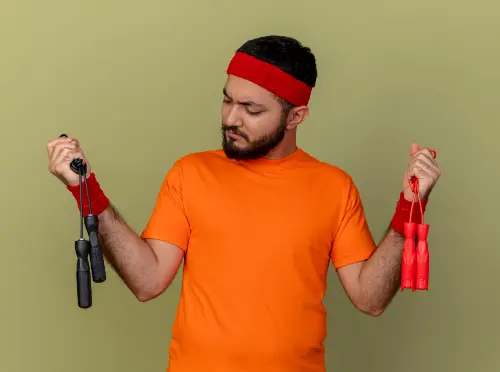Although cannabis use is gaining popularity in some sports circles, current scientific evidence shows that it does not enhance athletic performance. In fact, several studies confirm that cannabis—especially THC—can impair endurance, coordination, and cardiovascular function, all key factors in elite athletic performance. Some athletes report feeling more relaxed or better able to manage post-training pain, but these benefits are mostly anecdotal and lack solid scientific backing. CBD, the non-psychoactive compound in cannabis, is being studied for its potential positive effects on sleep, muscle recovery, and inflammation, although more research is still needed. THC remains banned by the World Anti-Doping Agency (WADA) during competitions, posing a legal risk for professional athletes. In short, while cannabis may offer some symptomatic relief, it is not an effective or recommended tool for boosting physical performance in elite sports.
🧠 Section: Does cannabis improve or hinder athletic performance?
Cannabis use in sports has grown in visibility and controversy. Many athletes have openly shared their experiences with the plant—some praising its relaxing and pain-relieving effects, others highlighting its risks. But what does the science really say about cannabis and athletic performance? In this article by Weedestiny, we explore evidence, popular myths, and the real physiological effects of cannabis on high-performance athletes.
🔬 What cannabis compounds are involved?
Cannabis contains more than 500 chemical compounds. The two most studied in sports are:
THC (Tetrahydrocannabinol): A psychoactive compound that can cause euphoria, altered perception, changes in coordination, and delayed reaction times.
CBD (Cannabidiol): Non-psychoactive; has anti-inflammatory, analgesic, and anxiolytic effects according to preclinical studies.
Both interact with the endocannabinoid system, a network of receptors in the body that regulate appetite, sleep, and pain.
🏋️♂️ Why do some athletes use cannabis?
Despite THC being banned by the World Anti-Doping Agency (WADA), 23% of athletes have reported using cannabis at some point. Reasons include:
Managing muscle or joint pain
Improving sleep
Reducing pre-competition anxiety
Post-workout relaxation
However, these perceived benefits are largely anecdotal and lack solid clinical research support.
💥 Impact of THC on physical performance
Current evidence indicates that THC does not improve athletic performance. In fact, it may cause:
Reduced cardiovascular endurance
Increased heart and respiratory rate
Higher risk of motor coordination errors
Early fatigue and impaired effort perception
Chronic cannabis use has also been linked to issues with motivation, memory, and concentration—key aspects in elite sports.
🧪 What about CBD?
CBD has been removed from WADA’s banned substances list since 2018. In animal studies, it has shown:
Anti-inflammatory potential
Muscle pain reduction
Neuroprotective effects
However, there is not enough human evidence to confirm its effectiveness in athletes. CBD remains experimental, though promising.
⚖️ Legal and ethical considerations
In most countries, THC is considered doping if urine concentration exceeds 150 ng/ml. This has led to notable suspensions, such as that of sprinter Sha’Carri Richardson.
Moreover, product quality varies. A 2017 study showed 69% of CBD products were mislabeled, and 21% contained undeclared THC, posing risks for professional athletes.
⚠️ Additional risks of cannabis use in athletes
Beyond physical performance, cannabis use can lead to:
Respiratory issues similar to or worse than tobacco
Withdrawal symptoms in frequent users
Potential intoxication from mislabeled products
Concentration and coordination problems in technical sports
It may also result in disciplinary sanctions or damage to an athlete’s public image, even if legal in their region.
🚬 How does smoking affect athletic performance?
Smoking—whether tobacco or cannabis—has significant effects on sports performance. Inhaling cannabis can impair respiratory function, motor coordination, and effort perception in both the short and long term. While some athletes report feeling more relaxed after smoking, scientific evidence shows THC typically reduces endurance, increases fatigue, and disrupts precision, especially in sports requiring reaction time and concentration.
From a cardiovascular perspective, smoking cannabis causes acute increases in heart rate and blood pressure, potentially reducing heart efficiency during exercise. Inhaling smoke also introduces tar, carbon monoxide, and other toxins, lowering aerobic capacity and reducing muscle oxygenation.
In short, smoking negatively affects both physiological and psychological aspects of performance. While it may offer subjective benefits like reduced anxiety, these are outweighed by its detrimental effects. In the context of cannabis and athletic performance, it’s essential to distinguish between different consumption methods and assess the real risks of smoking.
🧘 What are the effects of cannabis on muscle recovery?
Cannabis is often cited for helping with muscle recovery. Many users report feeling relaxed or sleeping better after hard workouts. But these claims are mostly anecdotal.
CBD, the non-psychoactive cannabinoid, has shown promise in reducing inflammation and muscle pain in preclinical studies. However, most of the evidence comes from animal models or lab settings—not from human athletes. THC, though it may provide some pain relief, poses risks like altered sleep patterns, poor coordination, and potential dependency.
In the cannabis and athletic performance debate, muscle recovery remains a gray area. While the plant may help some feel better subjectively, there’s still insufficient clinical proof to recommend it as a reliable recovery tool.
😴 Does CBD really help athletes sleep better?
Sleep is a cornerstone of athletic performance. Without quality rest, recovery suffers—impacting strength, endurance, and mental clarity.
CBD has become popular as a natural sleep aid, thanks to its calming effects. It interacts with endocannabinoid receptors that regulate mood and relaxation. Early studies show it may help with falling asleep and improving deep sleep phases.
However, there’s no conclusive evidence yet supporting CBD as a sleep aid specifically for elite athletes. Plus, many unregulated products contain hidden THC or contaminants, risking failed drug tests or health issues.
CBD has potential for improving rest but should be used cautiously and under medical advice. Its effectiveness in sports contexts still requires high-quality research.
🚫 Is cannabis allowed in sports competitions?
Cannabis use in professional sports is regulated by agencies like WADA. According to its code, THC is banned in competition, while CBD has been allowed since 2018.
Athletes testing above 150 ng/ml of THC in urine may be disqualified—even if consumed days before. That was the case with Sha’Carri Richardson. Regulations are strict regardless of local laws.
CBD is legal in sports as long as it’s pure. However, many CBD products are poorly labeled and may contain THC, posing a risk.
In the cannabis and athletic performance debate, knowing the legal rules is essential to avoid sanctions or damage to an athlete’s career.
🟣 CBD and Sports
CBD (cannabidiol), one of the main non-psychoactive compounds in cannabis, has generated growing interest in the sports world. Unlike THC, CBD does not produce psychoactive effects, making it an attractive option for athletes seeking therapeutic benefits without impairing cognitive performance or violating anti-doping rules. Since 2018, the World Anti-Doping Agency (WADA) has removed CBD from its list of banned substances, allowing its use during and outside of competitions. This change has encouraged many athletes to incorporate CBD products into their training and recovery routines.
The most frequently cited benefits of CBD in sports include reduced muscle pain, better sleep quality, decreased inflammation, and improved stress and anxiety management—all key elements for optimizing athletic performance. Additionally, its potential neuroprotective effects and positive influence on the body’s endocannabinoid system are being studied as tools to accelerate post-injury recovery or prevent overtraining.
However, despite promising signs, there’s still a considerable gap between anecdotal evidence and high-quality scientific research. Most current studies have been conducted in animals or general populations—not professional athletes. Therefore, clinical trials specifically focused on elite athletes are still needed to validate these effects.
In the context of cannabis and athletic performance, CBD may be a valid alternative for comprehensive athlete care. Still, it’s crucial to ensure product purity and absence of THC to avoid sanctions or unwanted effects.
🟣 Cannabis and Sports
The relationship between cannabis and sports has become a hot topic, especially as more amateur and professional athletes report using it. While cannabis has long been viewed as a recreational drug, its use in sports is rising due to its potential pain-relieving, anti-inflammatory, and relaxing properties. Some athletes use it to ease post-training pain, improve sleep, or manage pre-competition anxiety.
However, from a scientific standpoint, evidence supporting these uses remains limited. CBD, one of cannabis’s main compounds, is allowed in sports and shows therapeutic promise. In contrast, THC is still prohibited by WADA if its levels exceed the acceptable threshold in drug tests.
Cannabis—especially when smoked—can negatively affect performance. Documented side effects include impaired coordination, slower reaction time, increased heart rate, and decreased lung capacity. These impacts can severely hinder performance in sports requiring endurance, precision, or fast reflexes.
In conclusion, while many athletes report subjective benefits, the risks—both physiological and regulatory—are real. In elite sports, where every detail matters, any substance that can affect physical or mental performance must be scrutinized carefully. Within the broader discussion of cannabis and athletic performance, it’s crucial to separate marketing hype from scientific evidence.




